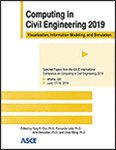ASCE International Conference on Computing in Civil Engineering 2019
Analysis of Lighting Occupancy Sensor Installation in Building Renovation Using Agent-Based Modeling of Occupant Behavior
Publication: Computing in Civil Engineering 2019: Visualization, Information Modeling, and Simulation
ABSTRACT
Lighting occupancy sensors offer great potential for decreasing lighting energy consumption by enhancing control options in residential and commercial buildings. Although occupancy sensors and their energy saving potential have been extensively studied through case studies, methods for investigating the feasibility of implementing this technology to renovate a specific building, considering a pre-defined occupant behavior, are very limited. This study introduces a framework that considers occupant behavior to analyze the impact of lighting occupancy sensors on the building lighting energy consumption, through the use of agent-based modeling. This study considers three main occupancy parameters, including number of occupants, occupant presence and movement, and occupant action behavior (i.e., switching the lights on/off in this case). The framework is able to analyze the feasibility of installing different lighting occupancy sensors and select the most cost-effective one, considering particular occupancy behavioral patterns. To validate the model, this study conducted a simplified office case study.
Get full access to this article
View all available purchase options and get full access to this chapter.
REFERENCES
Abraham, YS, Anumba, CJ, Asadi, S. (2018). “Exploring Agent-Based Modeling Approaches for Human-Centered Energy Consumption Prediction.” Construction Research Congress 2018.
Azar, E, Menassa, CC. (2012). “Agent-Based Modeling of Occupants and Their Impact on Energy Use in Commercial Buildings”. Journal of Computing Civil Engineering, 26(4), 506-518.
de Bakker, C, Aries, M, Kort, H, Rosemann, A. (2017). “Occupancy-based lighting control in open-plan office spaces: A state-of-the-art review.” Building and Environment, 112, 308-321.
Cao, J, Choi, C, Zhao, F. (2017). “Agent-based modeling of the adoption of high-efficiency lighting in the residential sector.” Sustainable Energy Technologies and Assessments, 19, 70-78.
Chappin, EJL, Afman, MR. (2013). “An agent-based model of transitions in consumer lighting: Policy impacts from the E.U. phase-out of incandescents.” Environmental Innovation and Societal Transitions, 7, 16-36.
Chen, J, Taylor, JE, Wei, H-H. (2012). “Modeling building occupant network energy consumption decision-making: The interplay between network structure and conservation.” Energy and Buildings, 47, 515-524.
Chung, TM, Burnett, J. (2001). “On the Prediction of Lighting Energy Savings Achieved by Occupancy Sensors.” Energy Engineering, 98(4), 6-23.
Daeke, A. (2010). “Occupancy Sensors Energy Saving Fact Sheet.” published on: <http://wastereductionpartners.org>. (2018).
Energy Information Administration (EIA) (2017). “Trends in Lighting in Commercial Buildings.” available on <https://www.eia.gov/consumption/commercial/reports/2012/lighting/>.
Environmental Protection Agancy (EPA) (2009). “Building and their Impact on the Environment: A Statistical Summary.” <http://www.epa.gov/greenbuilding/pubs/gbstats.pdf>. (2015).
Langevin, J, Wen, J, Gurian, PL. (2015). “Simulating the human-building interaction: Development and validation of an agent-based model of office occupant behaviors.” Building and Environment, 88, 27-45.
Lee, YS, Malkawi, AM. (2014). “Simulating multiple occupant behaviors in buildings: An agent-based modeling approach.” Energy and Buildings, 69, 407-416.
Lin, H, Wang, Q, Wang, Y, Liu, Y, Sun, Q, Wennersten, R. (2017). “The energy-saving potential of an office under different pricing mechanisms – Application of an agent-based model.” Applied Energy, 202, 248-258.
Mahdavi, A, Tahmasebi, F. (2015). “Predicting people’s presence in buildings: An empirically based model performance analysis.” Energy and Buildings, 86, 349-355.
Menassa, CC. (2011). “Evaluating sustainable retrofits in existing buildings under uncertainty.” Energy and Buildings, 43(12), 3576-3583.
Michigan Energy Office (MEO) (2007). “Energy Efficiency Information for the Facility Manager.” <https://www.michigan.gov/documents/dleg/EO_12-07_218809_7.pdf>. (2018).
National Optical Astronomy Observatory (NOAO) (2018). “Recommended Light Levels for Outdoor/Indoor Venues” published on <https://www.noao.edu>.
Wang, C, Yan, D, Ren, X. (2016). “Modeling Individual’s Light Switching Behavior to Understand Lighting Energy Use of Office Building.” Energy Procedia, 88, 781-787.
Yang, J, Santamouris, M, Lee, SE. (2016). “Review of occupancy sensing systems and occupancy modeling methodologies for the application in institutional buildings.” Energy and Buildings, 121, 344-349.
Yang, R, Wang, L. (2013). “Development of multi-agent system for building energy and comfort management based on occupant behaviors.” Energy and Buildings, 56, 1-7.
Information & Authors
Information
Published In
Computing in Civil Engineering 2019: Visualization, Information Modeling, and Simulation
Pages: 593 - 601
Editors: Yong K. Cho, Ph.D., Georgia Institute of Technology, Fernanda Leite, Ph.D., University of Texas at Austin, Amir Behzadan, Ph.D., Texas A&M University, and Chao Wang, Ph.D., Louisiana State University
ISBN (Online): 978-0-7844-8242-1
Copyright
© 2019 American Society of Civil Engineers.
History
Published online: Jun 13, 2019
Authors
Metrics & Citations
Metrics
Citations
Download citation
If you have the appropriate software installed, you can download article citation data to the citation manager of your choice. Simply select your manager software from the list below and click Download.
